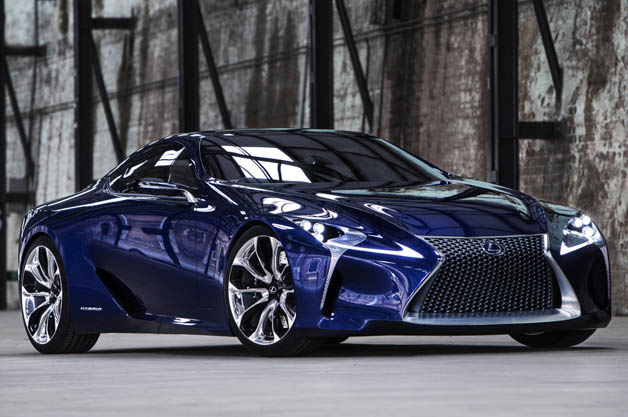Search This Blog
Thursday, December 18, 2014
Monday, December 8, 2014
Lexus files to copyright LC 500 nameplates
According to Lexus Enthusiast, the automaker has filed to trademark the names LC 500 and LC 500h in a variety of markets – including the United States, Canada and Australia. The application tells us a number of things: first of all, that the LF-LC will retain that second set of letters along the road to production (like theNX but unlike other recent Lexus concepts). And secondly, it indicates what engines we can expect to find under the hood.
The 500 designation would seem to suggest that the base version of Lexus' upcoming halo sports car will pack the 5.0-liter V8 from the RC F. The bigger question mark is over the hybrid version. Current gasoline-electric models in the company's lineup include the RX 450h (based on a 3.5-liter V6) and the LS 600h (with a 5.0-liter V8). For the LC 500h, Lexus could be planning a more potent electric motor to mate to the 3.5L V6, or planning a new powertrain altogether.
Saturday, November 8, 2014
Tuesday, October 28, 2014
CRISIS? WHAT CRISIS? F1 DIGS HEAD IN THE SAND
Monday, October 27, 2014
FORMULA 1 SET FOR THREE-CAR TEAMS AS CRISIS LOOMS LARGE
LOTUS SPONSOR: FERNANDO WILL LOOK GOOD IN BLACK & GOLD
Sunday, October 26, 2014
Thursday, October 23, 2014
ECCLESTONE HITS BACK AT TEXAS SPEEDWAY BOSS CRITICISM
Sunday, October 12, 2014
Friday, October 10, 2014
Sochi FP2: Hamilton leaves them in his dust
The championship leader’s best time of 1:39.630 in Free Practice 2 was a massive 0.894 of a second faster than his closest rival, during the afternoon session, and almost a second up on title rival and Mercedes teammate Nico Rosberg who ended the session fourth fastest.
Earlier Rosberg made history as the first Formula 1 driver to set a timed lap at the inaugural Russian Grand Prix in the morning session.
The Briton, who leads Rosberg by 10 points in the world championship standings after winning the last three races, went top of the timesheets in a slightly shortened session – the red flag came out eight minutes from the end when Australian Daniel Ricciardo’s Red Bull halted with a power unit failure.
McLaren‘s Jenson Button was the early pacesetter as drivers got to grips with a layout compared to the former Valencia street circuit and Singapore, with the 2009 champion ending the morning as the third fastest.
He also collected two fines totalling 1 100 euros for pitlane speeding and was sixth fastest in the second session.
Ferrari‘s Fernando Alonso was fourth and third in the two sessions, with Danish rookie Kevin Magnussen, Button’s teammate, fifth and then second in the afternoon.
The only Russian regular, Toro Rosso’s 20-year-old rookie Daniil Kvyat, followed up seventh in the morning with eighth after lunch.
That was still ahead of both Red Bulls, his 2015 employers, with four times champion Sebastian Vettel ninth after reporting a loss of power on the straight and Ricciardo 13th.
Williams had a disrupted opening session when a problem with a tyre blanket damaged a set of Valtteri Bottas’s tyres, limiting his running.
All drivers took to the track with stickers of support for Jules Bianchi, Marussia’s French driver who was severely injured in a crash in Japan last Sunday and remains in critical condition.
Marussia announced before the session that they would have only one car running this weekend, with Bianchi’s assembled and left in the garage as a mark of respect.
Chilton ended the first session with the slowest time but picked up speed in the afternoon, “I don’t know how to put into words how truly devastated I am by what has happened to Jules.”
“It is going to be a very emotional weekend for the whole team, but we will try to get through it and keep praying for Jules.”
Russian Grand Prix, Free Practice 2 at Sochi Autodrom – Friday, 10 October 2014
| Pos | No | Driver | Team | Time | Gap | Laps |
|---|---|---|---|---|---|---|
| 1 | 44 | Lewis Hamilton | Mercedes | 1:39.630 | 27 | |
| 2 | 20 | Kevin Magnussen | McLaren-Mercedes | 1:40.494 | 0.864 | 32 |
| 3 | 14 | Fernando Alonso | Ferrari | 1:40.504 | 0.874 | 32 |
| 4 | 6 | Nico Rosberg | Mercedes | 1:40.542 | 0.912 | 30 |
| 5 | 77 | Valtteri Bottas | Williams-Mercedes | 1:40.573 | 0.943 | 33 |
| 6 | 22 | Jenson Button | McLaren-Mercedes | 1:40.718 | 1.088 | 32 |
| 7 | 19 | Felipe Massa | Williams-Mercedes | 1:40.731 | 1.101 | 30 |
| 8 | 26 | Daniil Kvyat | STR-Renault | 1:41.108 | 1.478 | 32 |
| 9 | 1 | Sebastian Vettel | Red Bull Racing-Renault | 1:41.396 | 1.766 | 30 |
| 10 | 25 | Jean-Eric Vergne | STR-Renault | 1:41.531 | 1.901 | 33 |
| 11 | 7 | Kimi Räikkönen | Ferrari | 1:41.630 | 2.000 | 24 |
| 12 | 27 | Nico Hulkenberg | Force India-Mercedes | 1:41.677 | 2.047 | 27 |
| 13 | 3 | Daniel Ricciardo | Red Bull Racing-Renault | 1:42.061 | 2.431 | 25 |
| 14 | 11 | Sergio Perez | Force India-Mercedes | 1:42.090 | 2.460 | 29 |
| 15 | 99 | Adrian Sutil | Sauber-Ferrari | 1:42.233 | 2.603 | 31 |
| 16 | 8 | Romain Grosjean | Lotus-Renault | 1:42.892 | 3.262 | 30 |
| 17 | 13 | Pastor Maldonado | Lotus-Renault | 1:42.905 | 3.275 | 33 |
| 18 | 21 | Esteban Gutierrez | Sauber-Ferrari | 1:43.055 | 3.425 | 33 |
| 19 | 9 | Marcus Ericsson | Caterham-Renault | 1:44.135 | 4.505 | 22 |
| 20 | 4 | Max Chilton | Marussia-Ferrari | 1:44.530 | 4.900 | 29 |
| 21 | 10 | Kamui Kobayashi | Caterham-Renault | 1:44.952 | 5.322 | 27 |
Thursday, October 2, 2014
Monday, September 29, 2014
Saturday, September 27, 2014
Wednesday, September 24, 2014
Tuesday, September 23, 2014
Monday, September 15, 2014
Saturday, August 23, 2014
FIA says FRIC no to trick suspensions in F1
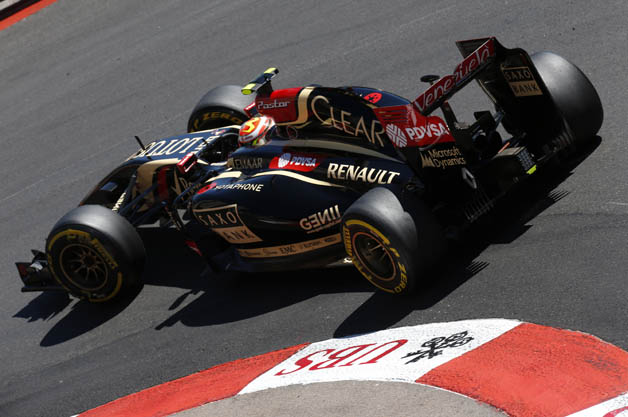
There are few fields in the world where you'll find engineers working as feverishly as they do in Formula One. With races sometimes won and lost by fractions of a second, every little bit counts, so each team retains legions of engineers, all dedicated to finding the tiniest performance edge... without running afoul of the ever-constricting regulations.
This season, one of the most controversial advances has been known as FRIC, and while it's been effectively sidelined for the last few races, reports from the motorsport press indicate that is has now officially been banned by the FIA.
So just what is FRIC? It stands for Front and Rear Inter-Connected suspension. Now, if you're thinking that independent suspensions are the most advanced form available, you're right, but F1 teams have been toying for years with ways to interlink the suspensions at each wheel. Why, you ask? For a number of reasons. For one, it allows for redistribution of suspension dive at the front or rear, which means that under hard braking or acceleration – when the car would either pitch back or forward – the car can be kept more stable. That, in turn, means not only are all four tires loaded evenly and optimally, but the team can also run a more aggressive aero package. It also means that the car can be set up with a softer suspension, allowing the driver to attack the curbs more aggressively, without sacrificing underbody aerodynamics.
Several teams had been running FRIC systems that move hydraulic fluid between the front and rear suspensions, but voluntarily agreed to cease using them for the last two races at Hockenheim and Budapest. Now, the FIA, having apparently deemed FRIC an unfair advantage in contravention of the sporting regulations, has reportedly banned the system altogether. So while those cars may not be running on an even keel any more, at least they'll all be on an even playing field.
Xcar takes a closer look at the electrifying Renovo Coupe
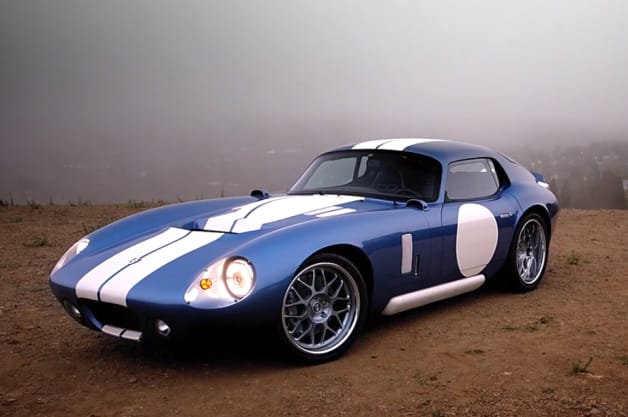
Xcar Films went to Pebble Beach and gave ex-Intel engineer and Renovo Motors CEO Christopher Heiser a platform to talk about his new electric supercar based on the Shelby Daytona Coupe. The relevant nuggets: 500 horsepower and 1,000 pound-feet of torque from direct-drive twin sequential axial flux motors powered by a lithium-ion battery, 0 to 60 in 3.4 seconds, top speed over 120 mph, 2,500 pounds, $529,000 to purchase.
While Heiser spends almost six minutes talking about the car and what it means to him, almost all of it is information we already know. When he gets to the bits that perk our ears, like when the mentions of advanced technology and upgraded parts, he skips the details. After four years of having to drive it at night to keep the secret, we don't even get to see more of what's inside, much less a daytime run with the Xcar chaps.
So we'll look forward to the next installment. In the meantime, this one's another beautiful entry in the Xcar catalog.
2015 Chevy Corvette Z06 priced at $78,995
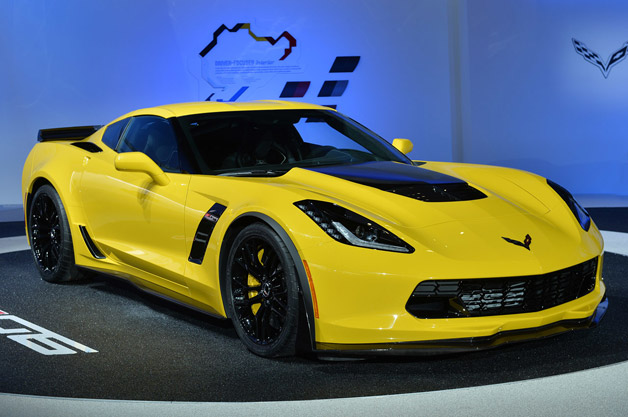
Want to get your hands on the most powerful vehicle GM has ever made? It may be time to call your bank manager, financial adviser and whoever else helps you get your monetary ducks in a row, because Chevy has now revealed pricing information for the new 2015 Corvette Z06.
Pricing starts at $78,995 for the coupe and $83,995 for the convertible. Both those figures include destination, but don't include things like tax, title, license and optional equipment. And as we revealed when the order guide surfaced, there is some enticing optional equipment on offer.
An extra $2,995 will get you the Carbon Fiber Ground Effects package with enhanced aero. $7,995 will get you the Z07 Performance Package with Brembo carbon-ceramic brakes, upgraded tires and even more aggressive aero. There are three trim levels available and a host of other packages and options you can read all about in the press release below, from the Premium Package leather trim to the Performance Data Recorder.
No matter which way you set it up, though, you're getting a 6.2-liter supercharged V8 with 650 horsepower and just as much torque. And though the price of entry may seem high, it comes down to a downright steal compared to the six figures Chevy got for the previous ZR1 (whose place the new Z06 effectively takes) and which Dodge gets for a new Viper.
Volkswagen considering a four-door, four-seat XL1
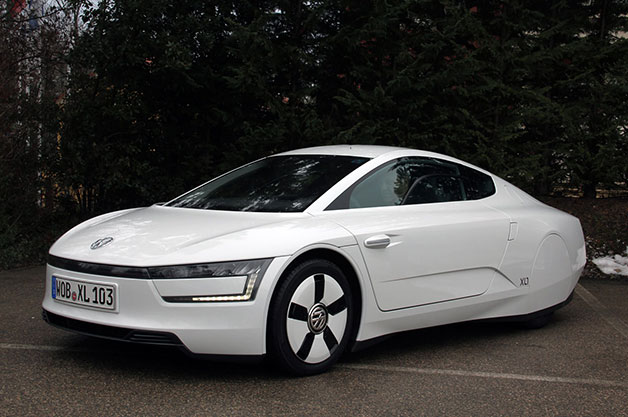
According to a report in Autocar, Volkswagen might have more in mind for the XL1 than mining it for advances to grace the next-generation Golf. Aiming to fight the Honda FCEV due for public consumption next year, we're told VW executives have put a four-door, four-seater version of the XL1 - it could be called XL2 - on the drawing board. The impetus is said to come from the top, with VW Group chairman Ferdinand Piëch intent on staying in the deep end of "super-efficent vehicles."
Autocar suspects the necessary changes could raise the weight of the car from 1,749 pounds to 2,068 pounds, which would make it four pounds less than the 2,072-pound Up! we drove a few years ago. Crucially, however, the mag thinks the extra capacity wouldn't change the two-seater's 310-mile-per-gallon rating, with tech tweaks and the aerodynamic benefit of a longer car offsetting the weight. Speculation is that the back seats would be staggered like the fronts in order to maintain the XL1's overall profile.
We recently heard about another XL1 variant that's gone off the radar entirely, the Ducati-engined XLR that we thought we'd see at the Geneva Motor Show and that was said to be going into production, so this one could go the same way. The biggest hurdle to making such an idea a reality, though, could be the price: the current XL1 costs 110,000 euros ($146,116). If VW really is going to compete with the Honda FCEV and the Toyota FCV - $70,000 in Japan - that might be where it wants to start.
2015 Chevy Corvette Z06 price and power compared against rivals
Ranking Z06 With Porsche, Ferrari, GT-R, Hellcat, Etc.
The 2015 Chevrolet Corvette Z06 is the most powerful production car ever from General Motors, and it's a technological landmark in the long lineage of Corvettes. It's also more affordable than you might think.
The 2015 Z06 starts at $78,995* – not chump change, but well below the price ranges of key competitors.As was announced earlier today, the 2015 Z06 has a starting price of $78,995 for the coupe and $83,995 for the convertible, *including $995 in destination charges. That's not chump change, but it's well below the price ranges of several of its key competitors.
The Corvette has long been compared with the Porsche 911, but the Z06's 650 horsepower and 650 pound-feet of torque easily eclipses the most powerful 911, the Turbo S (560 hp, 516 lb-ft). The Z06 also costs less than half as much, as the Turbo S has a starting MSRP of $182,700, and then tacks on a $995-shipping charge.
A closer comparison – pricewise – would be the Porsche Cayman GTS, which comes in with an MSRP of $75,200 – that's $2,800 cheaper than the Vette. Thing is, it has 310 fewer hp.
The Audi R8 is a slightly more formidable competitor to the Z06 based on pure power. The V10 Plus has 550 hp, and its mid-engine configuration is a better layout for pure driving dynamics. But, its pricing starts at $173,500, not including a $1,250-destination charge. The base R8 with its 430-hp V8 begins at $115,000.
Then there's another long-running Corvette rival, the Dodge Viper SRT, and its 640-hp V10 engine. For 2014, the Viper costs $99,885, which is up $2,000 from 2013. Add in $1,995 shipping (your Viper does come in an enclosed trailer), and the total comes to $101,880. The price listed on the SRT website is $102,485, which includes the gas-guzzler tax, but not shipping. Regardless, it's about $22,000 more than the new Z06.
The all-wheel-drive Nissan GT-R, meanwhile, dials up 545 hp from a turbo V6 for $101,770, which rises to $103,365 with shipping.
The Z06 also grades out well in the world of exotics. The Ferrari FF produces 651 hp from its V12, which edges out the Z06 (barely), though the Ferrari only makes 504 lb-ft – all for a sticker of about $300,000 – though it does offer all-wheel drive.
Flipping the script on the Z06, the 2015 Dodge Challenger SRT Hellcat pumps out 707 horses for a price tag of $59,995 and a $995 destination charge brings the sticker to $60,990. That's more power for less money than the Corvette, but the Challenger is also a much larger car, and it's more of a muscle car than a sports car.
In this age of gaudy horsepower figures and prices, the Hellcat vs. Z06 is a fitting example of how modern sports cars are not all created equal. While the Hellcat can blow the doors off of the Vette with its power specs, the Z06 is assuredly a better track car. Porsche and Ferrari loyalists will naturally gravitate to and pay more for products from their brands, and no horsepower figure or "low-low" sticker price will change that. Plus, the sports-car segment is small enough in terms of sales so as to seemingly play by its own rules. No matter how much horsepower the Corvette has, it won't do much to erode GM's Corporate Average Fuel Economy standing.
While the Hellcat can blow the doors off of the Vette with its statistics, the Z06 is assuredly a better track car.Still, the Z06 creates a seriously compelling value case for enthusiasts in search of power for a competitive price. Corvette spokesman Monte Doran reminded Autoblog that sharing parts and technology among Chevy vehicles has allowed the brand to keep prices of its high-end sports cars relatively low. The 2015 Chevy Corvette Z06 is the first Z06 to use a supercharged engine, the first to have a true convertible variant and the first to offer an eight-speed automatic transmission.
"Chevrolet has developed a successful model for sharing components with Corvette and other models in the portfolio," he said. "For example, the eight-speed transmission was designed for Z06, and will also be used in full-size trucks with the 6.2L; the carbon-ceramic brakes are shared between the Camaro Z/28 and Corvette Z06. This enables Chevrolet to offer stratospheric-levels of performance without stratospheric prices."
Dave Sullivan, manager of product analysis for AutoPacific, an automotive research firm, concurs:
"By sharing parts and components with higher-volume vehicles, GM can keep the price down on the Corvette," he said. "The Z06 could prove to be one of the memorable bargains of the century."
Sullivan expects the horsepower wars to continue, which is only good for enthusiasts.
"Look at the Ford GT a decade ago," he said. "It was about $150,000 for 550 HP and 0-60 in 3.7 seconds. For a little more than half that, you can get more power, better performance, and a car that the manufacturer is committed to building for many years to come. Inflation? What inflation?"
Tuesday, August 19, 2014
Thursday, August 14, 2014
Friday, August 1, 2014
Thursday, July 24, 2014
Unplugged Performance sweetens the look of your Tesla Model S for around $6,000
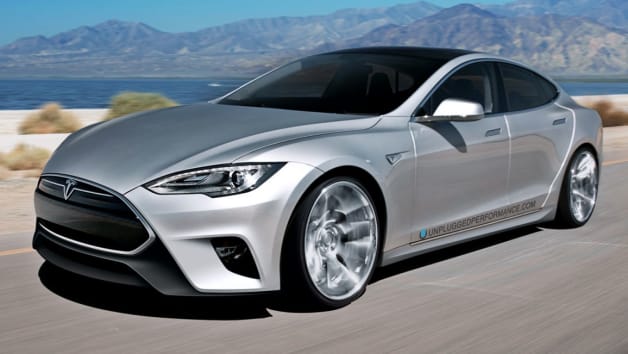
Tesla electric vehicles are no strangers to the tuner set. Saleen is working on a modified Model S. Brabus once offered neon for your Roadster. And new we find a number of body panel upgrades for the Model S from Unplugged Performance.
Unplugged Performance has its offices right by the Tesla's Supercharger in Hawthorne, CA, and sales manager Mark Borushko told AutoblogGreen that Tesla employees often express their appreciation for what UP has done to change the look of the Model S. The upgrade parts are made in the US and were designed in-house by an ex-Ferrari guy, Borushko said.
What upgrades are there? There's the front spoiler and diffuser (starting at $995), the rear spoiler and diffuser ($1,550), trunk spoiler ($895), side skirts ($1,450) and the Complete Front Fascia System ($1,000). Those prices are all for the unpainted parts. Add a few hundred bucks to each to upgrade to matching paint colors or carbon fiber parts. Borushko said that in the year that Unplugged Performance has been around, they've sold about 30 kits – meaning one of everything – worldwide. There are people who just buy just the trunk spoiler, for example, he said, but about 90 percent of UP's customers opt for the full kit. Borushko said UP will have to see if there's interest in a kit for the Model X, but there likely will be.
Unplugged Performance is a part of Bulletproof Automotive, which offers upgrades for all sorts of vehicles. The Unplugged Performance phone number is the same as the one for Tesla Everything, so we're pretty sure someone over there is a big Model S fan.
Lamborghini Aventador art car features every color of the rainbow
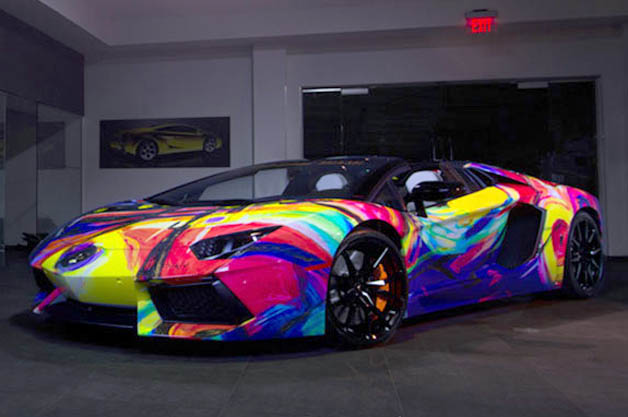
With a catalog packed with shades of orange and yellow, the Lamborghini Aventador doesn't shy away from bright colors. But the stock palette still pales in comparison to this latest art car.
This technicolor Aventador Roadster was created by Franco-American artist and musician Duaiv, who previously applied his talents to Ferraris like the FF and 458 Spider. Lamborghini Miami, a division of Prestige Imports in North Beach, Florida, applied the evidently very successful artist's painting to a vinyl wrap and fitted to the Lambo along with a Novitec rear spoiler to create a one-of-a-kind supercar that is anything but a sleeper. You know, just in case an Aventador didn't already stand out enough.
2015 Acura NSX burns to the ground at the 'Ring
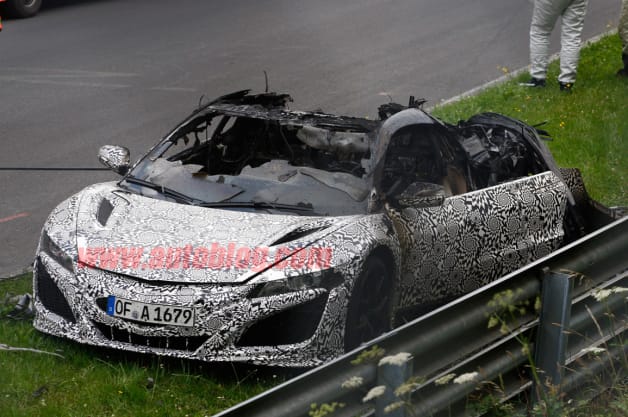
Assuming all goes to plan, automakers test their vehicles to the breaking point in the months and years leading up to that vehicle's actual release into the public. Which is good, because it's much better for a car to break in glorious fashion in the hands of the company that produces it than in the driveway of an owner who just spent their hard-earned cash to get it.
Such was the case with this production-guise Acura NSX prototype that we saw running around the Nürburgring just the other day. We can't be 100-percent certain, but the burned-out carcass is wearing the same number plate as the car that was spotted earlier, so it's likely the very same NSX. We have no idea what was the cause of the blaze that turned this Acura into the car-b-q you see pictured above, but our spy shooters on the ground in Germany say it was not involved in any collision, having caught on fire all on its own with engineers behind the wheel.
The good news is that nobody was hurt, though the car is quite clearly a complete loss. We're sure there's another ready to to test in the burned car's place... just as soon as the engineers at Honda figure out exactly what went wrong. Have a look at the smoldering aftermath up above.
Monday, July 21, 2014
2015 Ford Expedition
Blue Oval 'Burb-Fighter Boasts Turbocharged Boost
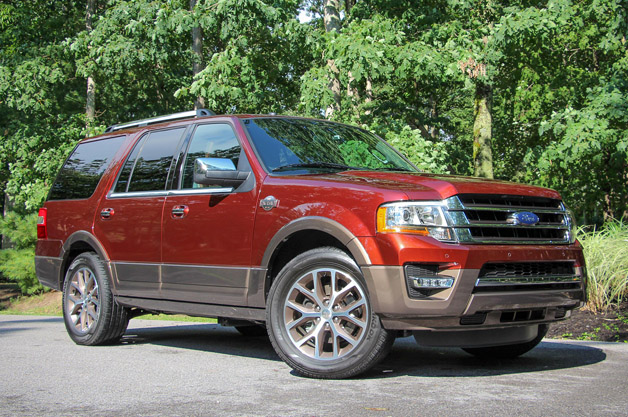
Vital Stats
- Engine:
- Twin-Turbo 3.5L V6
- Power:
- 365 HP / 420 LB-FT
- Transmission:
- 6-Speed Auto
- Base Price:
- $40,000 (est)
- As-Tested Price:
- $58,000 (est)
While the tide of bigger-is-better SUVs has been in recession since, well, the recession, fullsize utes are still very much with us. Conservative creatures that have been loathe to evolve, fullsize SUVs nonetheless remain enduringly popular among large families, livery customers, and anyone with lots of friends, relatives, and toys to tug around. With respect to Toyota and Nissan, the only players that really matter in the segment are the new-for-2015 Chevrolet Tahoe/Suburban, the GMC Yukon/Yukon XL, and this truck: the Ford Expedition.
Speaking of high-end models, a new Platinum trim is positioned above the cowboy-spec King Ranch model for 2015. Both the Platinum and King Ranch get their own color combos and exterior trim finishes (satin metal for the Platinum, chrome everywhere and ginormous badges for the King Ranch) and posh, leather-lined interiors with their own aesthetic. The Expedition family also now includes a price-leading XL model, as well as XLT and Limited grades.
That's nice and all, but we didn't fly to Appalachia to ogle new headlights and caress leather seats. The real draw was to see how the Expedition fares after making the switch from its outgoing V8 to turbocharged V6 power, the only way it will come henceforth. The change makes sense on paper, given that the turbo six – the same engine found in the F-150 EcoBoost – simply trounces the old V8 with 365 horsepower and 420 pound-feet of torque, compared to the outgoing 5.4's 310 hp and meager 365 lb-ft of torque. Notably, the EcoBoost V6 also outmuscles the 355 hp and 383 lb-ft of torque produced by the 5.3-liter base V8 in GM's portfolio, though it comes up shy of their forceful – and thirsty – optional 420-hp, 460 lb-ft 6.2-liter V8.
Saturday, July 12, 2014
Newest and Greatest from Porsche at Circuit of the Americas
Selling the Porsche 918 with leather, driver coaching and other special wishes
Also, it is a convertible. You’d think it wouldn’t be too hard to sell.
But it costs $865,000. And they're building 918 of them, unlike the more exclusive LaFerrari (499) and McLaren P1 (375). You can’t exactly slap a zero-percent financing sticker on it and put up TV ads for a 4th of July sale. Getting the Spyder in the hands of people who both can afford it and appreciate its majesty has been a multi-year process. Porsche has done everything it can, short of performing the Dance Of The Seven Veils, to seduce its potential buyers.
Every one of those 918 will be pressed to order and for those who signed up early, the wait is over. “Ralph Lauren got his car,” someone from Porsche told me. “Penske got his car. Seinfeld got his car.”
But there are still plenty available. In order to move their stock of The Greatest Car Ever Told, Porsche has been sending invitations out to people in its VIP program, potential customers who are either already high-end Porsche owners or owners of other supercars. This program is called “Porsche Exclusive,” though it used to be called “Special Wishes.” The name got changed, for obvious reasons. If wishes were Porsches, rich people would ride.
These are the kinds of customers who travel to Germany to consult on specs, or go to a dedicated Porsche design office in Beverly Hills. If they pay, they get whatever they want. One buyer is waiting until car number 666 rolls off the bespoke production line. I’m hoping its Ozzy Osbourne, though no names were revealed. (The top exhaust pipes would make terrific devil horns).
Of late, exclusive customers have been getting access to track days at five locations around the country, which includes a walkaround of a pre-production Spyder, plugged into a wall unit like an ordinary Chevy Volt, some light catering, a couple of runs around the track in a quotidian 911 Turbo, and, finally, a few laps in the Spyder itself. The appointments are spaced out 45 minutes apart, to give the illusion of exclusivity. Everyone is allowed to bring one guest.
Porsche set up shop earlier this month for a couple of days at the Circuit Of The Americas in Austin. There, I met David Donohue, former champion of the GT2 class at the 24 Hours Of Le Mans. As of now, he’s also Porsche’s in-house 918 Spyder consultant, available at all times to any owner who needs his help and advice. “When these customers call,” he said, “I can’t say, ‘sorry, I’m on a race weekend.’”
Donohue has a long history working with Porsche, but he says he was drawn to the Spyder not only because of its performance, but also because of the technological advances it represents. The fact that it’s the fastest consumer car in existence, and also the most fuel-efficient hybrid, represents good news for car lovers who are feeling buffeted by the winds of climate change. “CAFE regulations and environmentalists are making us drive neutered cars,” Donohue told me. “And this is how Porsche responds.” It is sweet revenge.
I spent several hours at COTA, watching VIPs stagger around in shock after driving the Spyder, and did my own share of staggering after taking my laps. Shelby on a Popsicle stick, what a car. But that didn’t mean they were flying off the virtual lot. Most everyone else seemed exist in “I have to think about it” mode. They were wealthy, but not Jay Leno wealthy. One guy sat a table, looking through colored leather samples as desultorily as though he were picking out a new couch.
But I did meet one bona fide 918 Spyder owner. Dean Rogers, retired from the recording-studio business, had come down to Austin from Santa Fe, N.M., along with his garage manager, who helps maintain his dozen cars of various vintages. Rogers put down his deposit three and a half years ago, the day Porsche announced the Spyder on Dec. 3, 2010. “What they were claiming at the time seemed totally impossible,” he said. “It was a leap of faith. No one had ever done it before. But if you’re gonna have faith in a car company, have faith in Porsche.”

Rogers went to Stuttgart to see early models. The exhaust originally came out the side. (Now it comes out of the rear, through twin pipes.) It had tiny cameras instead of side mirrors. The steering wheel came off. It all seemed kind of weird.
“But I stayed focused on it,” he told me. “I was offered a P1 by McLaren, and I turned it down. I was offered a (Bugatti) Veyron, turned it down. The Spyder ended up being even cooler than the concept. I feel very fortunate to be able to drive this car, to even have the opportunity. It’s like a miracle.”
And that was before he’d taken his spin around the world’s most state-of-the-art racetrack. When he got out of the car, Rogers was almost quaking with excitement.
“The power was unbelievable,” he said. “I did the back straight in race mode. As far as traction and grip, it’s unlike anything else I’ve driven. It feels like I’m ten years in the future. At least ten. Everyone said Porsche couldn’t do it. But they did it. They really did it.”
Rogers said he plans to drive the Spyder in the Dust Bowl Rally, an exclusive drive of 30 cars, from Austin to Chicago in August. He’ll have some time to noodle around at home in it before then. Porsche was going to drop off his Spyder last week. His special wishes have come true.
